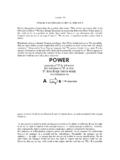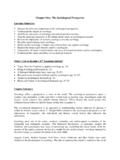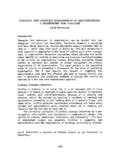Transcription of 1 Individual Self, Relational Self, and Collective Self
1 1 Individual self , Relational self , and Collective self Partners, Opponents, or Strangers? CONSTANTINE SEDIKIDES MARILYNN B. BREWER his volume is based on the premise that the self - concept consists of three fundamental self -representations: the Individual self , the rela-tional self , and the Collective self . Stated otherwise, persons seek to achieve self -definition and self -interpretation ( , identity) in three funda-mental ways: (a) in terms of their unique traits, (b) in terms of dyadic rela-tionships, and (c) in terms of group membership (Brewer & Gardner, 1996). The Individual self is achieved by differentiating from others ( , the Individual self contains those aspects of the self - concept that differentiate the person from other persons as a unique constellation of traits and charac-teristics that distinguishes the Individual within his or her social context).
2 This form of self -representation relies on interpersonal comparison pro-cesses and is associated with the motive of protecting or enhancing the person psychologically (Brewer & Gardner, 1996; see also Markus, 1977; Sedikides, 1993). The Relational self is achieved by assimilating with significant others ( , the Relational self contains those aspects of the self - concept that are shared with relationship partners and define the person's role or position within significant relationships). The Relational self is based on personalized bonds of attachment. Such bonds include parent-child relationships, friend-ships, and romantic relationships as well as specific role relationships such as teacher-student or clinician-client.
3 This form of self -representation relies on the process of reflected appraisal and is associated with the motive of T 2 Individual self , Relational self , Collective self protecting or enhancing the significant other and maintaining the relation-ship itself (Brewer & Gardner, 1996; see also Hazan & Shaver, 1994; Reis & Shaver, 1988). The Collective self is achieved by inclusion in large social groups and contrasting the group to which one belongs ( , the in-group) with relevant out-groups. That is, the Collective self contains those aspects of the self - concept that differentiate in-group members from members of relevant out-groups. The Collective self is based on impersonal bonds to others derived from common (and oftentimes symbolic) identification with a group.
4 These bonds do not require close personal relationships among group members. Turner, Hogg, Oakes, Reicher, and Wetherell (1987) defined succinctly the Collective self as a "shift towards the perception of self as an interchange-able exemplar of some social category and away from the perception of self as a unique person" (p. 50). The Collective self relies on intergroup comparison processes and is associated with the motive of protecting or enhancing the in-group (Brewer & Gardner, 1996). We assume that these three self -representations coexist within the same Individual . We also assume that all three self -representations are social (Simon, 1997). There is considerably less agreement, however, about the nature of the interrelations among the three self -representations.
5 Are the Individual , the Relational , and the Collective self close partners, bitter opponents, or in-different acquaintances? This is the fundamental question that the contribu-tors to this edited volume were asked to address in their respective chapters. The overall emphasis of the volume is on exploring and delineating the possible interactive relations among the three self -representations. This objec-tive was approached from several angles. One approach involves focusing on one self -representation as primary ( , arguing for the structural, functional, affective, motivational, or behavioral predominance of one type of self as a basis for self -definition) and then discussing how this self -representation gives rise to or underlies the other two.
6 A second way to explore the interplay among the three self -representations is to argue that the three self -representations are equally important or primary as separate aspects of the self . This approach involves specifying the determinants of activation of each self as well as the circumstances under which one self takes precedence over another in guiding self -definition. From this perspective, the three self -representations can be conceived as complementary, adversarial (mutually exclusive), or functionally independent. A third approach to the issue of interaction among the self representa-tions is some type of synthesis in which the various self -representations are integrated into a single model of the self - concept .
7 The contents of this volume make use of all three approaches to the question of the interrelationships among the Individual , Relational , and col-lective selves. The chapters in part I explore the three self -representations from the vantage point of the Individual self . Sedikides and Gaertner argue Individual self , Relational self , AND Collective self 3 that the Individual self is primary on two grounds: emotional and motiva-tional. Klein argues for the memorial primacy of the Individual self based on laboratory and clinical evidence, whereas Higgins and May advocate the regulatory primacy of the Individual self . By contrast, the contributors to part II view the interrelations of the three self -representations from the vantage of the Relational or Collective self .
8 Tice and Baumeister muster evidence for the importance of the interpersonal self and the need to belong, whereas Hogg catalogs the sovereignty of the Collective self in everyday life. Aron and McLaughlin-Volpe, as well as Smith, Coates, and Murphy, specify psychological processes by which the Relational and Collective self become primary or subsume the Individual self . Part III adopts an interactional perspective based on the premise that the three self -representations are equally important in the achievement of self -definition. Four chapters specify the contextual conditions ( , numerical or social status of the group; Onorato Spears; Simon & Kampmeier) and the psychological conditions ( , cognitive, motivational, or affective states; Brewer Simon & Kampmeier) that determine complemen-tary, adversarial, or interactive relations among the three types of selves.
9 The final section of the volume, part IV, presents several different inte-grative models. Four chapters (by Caporael; Triandis & Trafimow; Kashima, Kashima, & Aldridge; Deaux & Perkins) offer conceptual models on how the three self -representations can function as a unified psychological system. Finally, a commentary by Prentice identifies running themes, synthesizes the literature, and points to future research directions. The multiplicity of self -representations recently has become an important issue in social and personality psychology. Relevant journal articles appear on a monthly basis, and symposia dedicated to the topic abound at international conferences. While multiple perspectives on the self proliferate, it is relatively rare that theorists from different perspectives are asked to confront competing views of the nature of the social self and to consider the implications of their own position for a more unified theory of the structure and function of the self - concept .
10 Contributors to this volume were asked to do just that, and we believe they each have taken on the task admirably. The result, we hope, has been to push the envelope of theory development a bit further by clarifying competing positions and suggesting some bases for reconciliation. No "final answers" are proposed or implied, but the Collective effort should advance theory and stimulate new research in this vital area at the interface of personality and social psychology. REFERENCES Brewer, M. B., & Gardner, W. (1996). Who is this "we"? Levels of Collective identity and self representations. Journal of Personality and Social Psychology, 71, 83-93. 4 Individual self , Relational self , Collective self Hazan, C.








